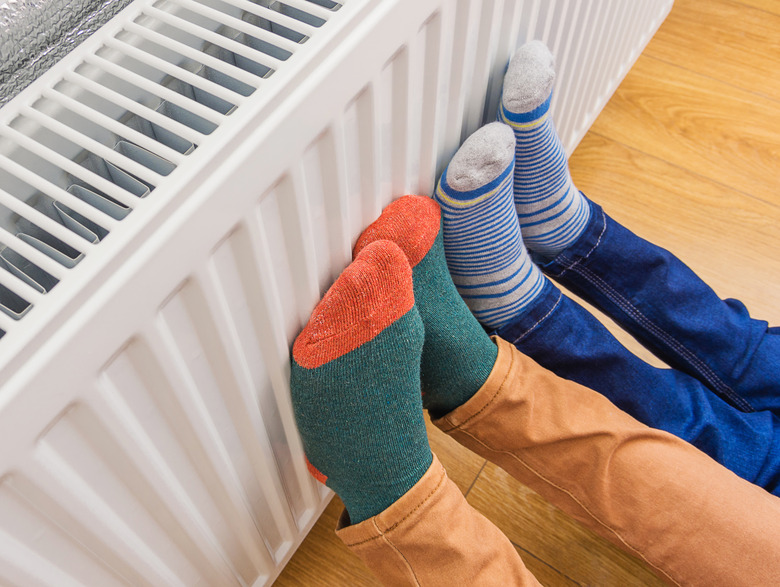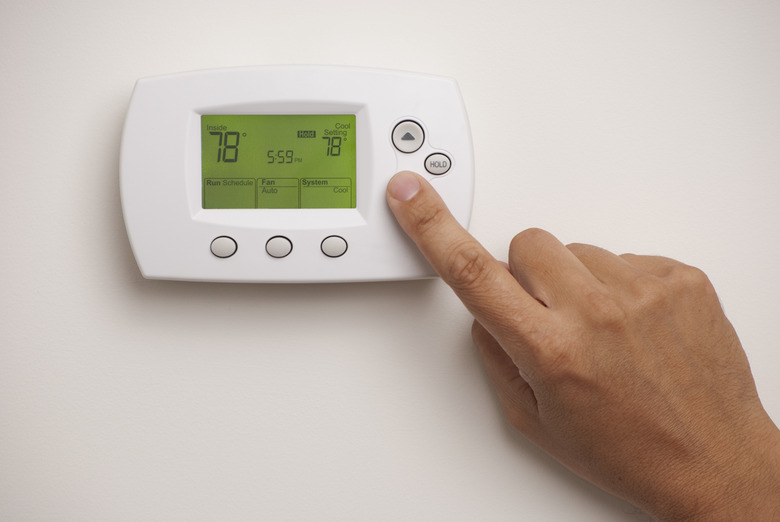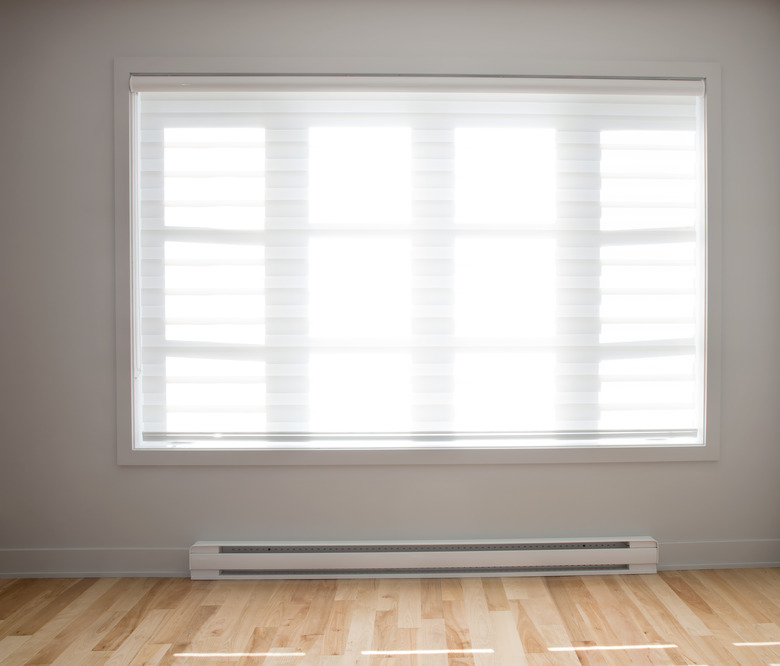Electric Heat Vs. Gas Furnace — Which Is Best For Your Home?
We may receive a commission on purchases made from links.
Whether you're remodeling an older house, building a new one, or simply fed up with your current heater, you might find yourself thinking about a new or an upgraded heating system — and you might be weighing the pros and cons of a gas furnace vs. electric heat. In a home with existing natural gas piping, the decision to opt for gas heat seems like a no-brainer given that gas is cheaper than electricity in every part of the country. Things aren't so clear cut, though, because even though it's more expensive, electric heat has a lot going for it.
Among the advantages of electric heat is that electric appliances cost less and last longer; the life span of an electric furnace, for example, is 30 years, whereas a gas furnace typically lasts for only 20. Electric appliances also have no effect on indoor air quality, whereas gas appliances always carry the risk of carbon monoxide exposure. However, to dispel a myth many homeowners believe, electric heat is not cleaner than gas. In fact, in terms of overall environmental impact, it's definitely not eco-friendly.
Tip
A gas furnace costs more to install than electric heat, but it costs less to operate. However, cost isn't the only factor to consider — and electric heat makes a lot of sense for certain situations even if it is more expensive.
Eco-Friendliness of Gas vs. Electric Heat
Eco-Friendliness of Gas vs. Electric Heat
The proliferation of electric vehicles on the road signals a shift away from engines that burn fossil fuels, and while that's a hopeful sign, it doesn't solve the problem that 60 percent of the electricity for charging batteries is produced by burning fossil fuels, according to 2020 data from the U.S. Energy Information Administration. Moreover, 20 percent of the fuel is coal, which is the dirtiest of all energy sources, and the process of producing and transmitting electricity is only 40 percent efficient at best. In other words, most of the energy is lost. Things are bound to change as we move increasingly in the direction of renewable energy to increase the energy efficiency of the grid, but for now, electrical energy is anything but clean.
This is the main reason a gas furnace is more eco-friendly than an electric one, even though electric furnaces are more energy efficient. Both natural gas and propane burn cleaner than coal, and current regulations require gas furnaces to be at least 80 percent energy efficient — and some are much more efficient than that. An electric furnace may have an annual fuel utilization efficiency (AFUE) rating of 100 percent (which means all the electricity is converted to heat), but a top of the line high-efficiency gas furnace can have an AFUE of 97 percent or more, which isn't much worse.
The main ecological drawback of a gas furnace is the potential for a malfunction that releases carbon monoxide into the home, which is why every home with this type of heating must be equipped with a carbon monoxide detector for safety.
Comparing Upfront and Operating Costs
Comparing Upfront and Operating Costs
On the whole, electric furnaces are less expensive than gas furnaces, and installation is also cheaper because electric furnaces are easier to install. Additionally, every home has an electrical system, so while new circuitry may have to be established, an electric furnace does not require installation of new gas pipes or a propane tank in the backyard as a gas furnace would if the gas infrastructure isn't already there. The cost to purchase and install an electric furnace is between $2,000 and $4,000, while for a gas furnace, it's between $4,500 and $6,000 — and that cost doesn't cover installation of gas pipes.
If you opt for a gas furnace, you'll make up for the extra upfront costs by paying less for gas than you would for electricity. Comparing operating costs is complicated by the fact that electrical power output is measured in kilowatt-hours, heat output is measured in British thermal units (BTU), and gas consumption is measured in gallons, but ultimately an electric furnace costs on average about two-and-a-half times as much to operate as a gas one. This is highly dependent on where you live because gas and electricity costs fluctuate around the country.
You'll also save on maintenance costs if you choose an electric furnace. Gas furnaces require a yearly tune-up at bare minimum, and they are prone to vent and drain line blockages and shutdowns due to failure of sensitive controls and cracks that can release carbon monoxide. Electric furnaces, on the other hand, are virtually trouble-free, requiring at most the regular filter replacement you would expect with any HVAC system.
Choosing an Electric or Gas Furnace
Choosing an Electric or Gas Furnace
No matter what fuel your furnace uses, it has to provide enough heat to warm the house, but it shouldn't put out more heat than necessary, or it will cycle on and off too frequently and shorten its service life. The heating capacity of a furnace is measured in tons (1 ton = 12,000 BTU), and it's best determined by a heat load calculation conducted by an HVAC technician. The tonnage is a measure of the "size" of the furnace, and if you choose a gas furnace, you have to make one more decision, and that's the furnace efficiency. (You don't have to worry about efficiency when purchasing an electric furnace because they are all 100 percent efficient.)
A standard-efficiency gas furnace is one with an AFUE rating of at least 80, while a high-efficiency furnace has an AFUE rating of 90 or more. Both standard- and high-efficiency gas furnaces are cheaper to operate than electric furnaces, but if you're concerned about emissions and energy savings, you should choose a high-efficiency one. The difference in price can run into the thousands of dollars, but high-efficiency furnaces last longer and may even qualify you for a tax credit. Because they draw air from outdoors and not their surroundings, they should be in a sealed room, so if you're replacing a furnace in a well-ventilated space, such as an old basement, a standard-efficiency model will better serve you.
It's important to note that if you live in a region that experiences frequent power outages, you won't be better off with a gas furnace than an electric one. Delivery of the primary fuel to a gas furnace, which may be natural gas from the gas company or propane from a tank in the yard, may be unaffected, but the furnace still uses electricity to power the gas valve and other controls as well as the blower that circulates the hot air, and none of these electrical components will work if the power is cut off. You'll be just as much in the cold during an outage as you would be if you had an electric furnace.
Electric Heat Gives More Options
Electric Heat Gives More Options
If your house doesn't have an existing HVAC system complete with ductwork, you'll have to install one to use a gas furnace, but that isn't true if you opt for electric heat. In lieu of a central electric furnace, you can heat on a room-by-room basis using electric baseboard heaters, radiant cove heaters, electric radiant floor heat and wall-mounted heaters and wall panels, and you can deploy space heaters at will in areas that aren't warm enough. The cost of energizing all these resistive heating elements at the same time would hike your electric bill considerably, but you can keep the cost down by using electric heaters selectively to warm only the parts of the house you use and by cycling each heater on and off using a programmable thermostat.
If you are attracted to natural gas or the lower cost, you don't have to install a furnace and ductwork. Instead, if your house is under construction or undergoing a remodel, you might consider installing hydronic radiant floor heat, which circulates hot water heated by a gas-fired boiler (which can double as a water heater). Unlike electric floor heating, hydronic floor heating is a cost-effective home heating system for the entire house, but to get the most benefit, you should install it in the floor, not under it. The best time to do it is when the subfloor is exposed; otherwise, installation costs can be very high.
Electric Heat Pump vs. Gas Furnace
Electric Heat Pump vs. Gas Furnace
There is one type of electrical heating system that can potentially cost less to operate than a gas furnace, and that's a heat pump. In this case, electricity isn't used to make heating elements glow, which is extremely energy intensive, but to transfer heat from the outside air or water or from the ground via a refrigerant coil. In this case, the electricity runs a compressor, which consumes about as much energy as a large refrigerator, and a blower. A heat pump can double as an air conditioner, so it's a year-round climate control solution. Heat pumps can also be installed without ductwork; minisplit systems consist of multiple wall units operated by a single compressor situated just outside the building.
Heat pumps don't work as well as gas furnaces in colder climates and may have to be supplemented with other types of resistive heaters in the most-used parts of the house. A home in a cold climate with existing gas infrastructure and ductwork would benefit more from a gas furnace. It pumps out more heat than a heat pump — or even an electric furnace — it heats the air more quickly, and it eliminates the need for supplemental heat.
Homeowners most likely to benefit from central electric heat pumps and minisplit electric heating systems are those in moderate climates where due to the availability of heat pumps, gas heating might be considered overkill. Heat pumps are much more energy efficient than electric resistive heaters and rival gas furnaces for cost-effectiveness, and because of the availability of the minisplit option, they are as adaptable as other types of electric heaters. Minisplits require no ductwork, and each indoor unit has its own thermostat, so you can turn off the heat in rooms you aren't using and save money.
References
- U.S. Energy Information Administration: What Is U.S. Electricity Generation by Energy Source?
- U.S. Energy Information Administration: More Than 60% of Energy Used for Electricity Generation Is Lost in Conversion
- Entek Corporation: Which Is Best? Electric Furnace or Gas Furnace
- Fixr: Gas vs Electric Furnace
- PickHvac: Gas Furnace vs Electric Furnace: 6 Main Factors Comparison
- Direct Energy: Gas vs. Electric Appliances: Compare Cost and Efficiency


